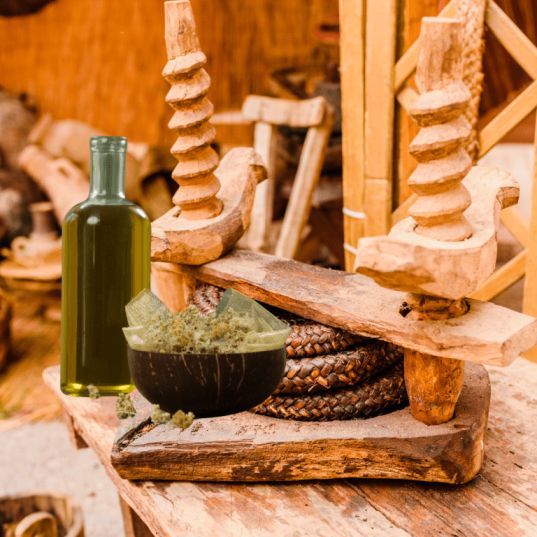Why Make Wood-Pressed Oils at Home?
Making wood-pressed oils at home is great because you use fresh seeds and control how the oil is made, keeping all its natural nutrients and taste. Homemade oils don’t have chemicals or additives, so they’re healthier. You can choose the seeds and how you press them to match your taste. It also saves money and feels satisfying to make yourself. Plus, you don’t have to rely on store-bought oils, which might not be as pure or high-quality.
What You Need to Get Started
To make wood-pressed oils at home, you need a few things. Get good seeds or nuts, like sunflower or sesame. You’ll also need an oil press, either wood or metal, to squeeze out the oil. Have clean containers for collecting and storing the oil. Use a strainer or cheesecloth to remove any solid pieces. Set up a clean, dry space to work and have some basic kitchen tools ready. These items will help make the process easy and smooth.
Choosing the Right Wood Press
Choosing the right wood press is key for making good wood-pressed oils. Look for a press made from strong materials like metal or sturdy wood. It should have a powerful mechanism to handle your seeds or nuts. A press with adjustable settings is useful for different seeds. Make sure it’s easy to put together and clean. Also, consider the press’s size to match your needs, whether you’re making small or large amounts. A good press will improve your oil-making process and results.
Selecting High-Quality Seeds and Nuts
To make great wood-pressed oils, choose fresh, clean, and undamaged seeds or nuts. Organic seeds or nuts are better because they don’t have chemicals. The type of seed or nut will affect the oil’s taste and quality, so pick ones with a rich flavor. Store them properly to keep them fresh before pressing. Using good-quality ingredients will make your homemade oil taste better and be healthier.
Other Necessary Tools and Materials
Besides the wood press, you’ll need a few extra tools and materials. Get clean containers to collect and store the oil. Use a strainer or cheesecloth to remove any solid bits from the oil. A funnel will help pour the oil into bottles easily. You may also need a scale to measure seeds or nuts and a spatula to move them. Make sure you have a clean, dry space and basic kitchen tools like bowls and spoons for preparation. These items will make the process easier and work better.
Preparing the Ingredients
Preparing ingredients for wood-pressed oils is easy. Start by cleaning the seeds or nuts well to remove dirt. Dry them completely to keep the oil from being affected by moisture. Use a scale to measure the right amount. For some seeds, you might need to roast or heat them lightly to improve flavor or extraction. Keep the prepared seeds or nuts in a clean, dry container until you’re ready to press them. Good preparation will help you get high-quality oil.
Cleaning and Drying the Seeds/Nuts
To prepare ingredients for making wood-pressed oils, follow these steps: Clean the seeds or nuts well to remove any dirt. Dry them completely so moisture doesn’t affect the oil. Use a scale to measure the right amount. Depending on the seeds, you might need to roast or lightly heat them to get better oil and flavor. Store the cleaned and prepared seeds or nuts in a clean, dry container until you’re ready to press them. Good preparation is key to making high-quality oil.
Pressing the Oil
Pressing oil is simple. First, make sure your press is clean and set up properly. Put the seeds or nuts into the press as directed. Turn the handle or operate the press to squeeze out the oil. Collect the oil in clean containers. You may need to filter it through a strainer or cheesecloth to remove any solid pieces. Store the filtered oil in airtight bottles or jars in a cool, dark place to keep it fresh. Good pressing and storage will give you the best oil.
Setting Up the Wood Press
Setting up the wood press is easy if you follow these steps. First, read the manufacturer’s instructions to understand how to put it together. Place the press on a stable, flat surface so it works properly. Assemble the press according to the instructions, making sure all parts are securely fitted. Clean the press and make sure it’s free of any debris. If the press has adjustable settings, adjust them based on the seeds or nuts you’ll use. Make sure the area around the press is clear and ready. Proper setup helps the oil extraction process go smoothly.
The Pressing Process
To press oil well, first load the seeds or nuts into the press without overfilling. Turn the handle or use the press as directed to squeeze out the oil. Collect the oil in clean containers. After pressing, filter the oil through a strainer or cheesecloth to remove any solid pieces. Store the filtered oil in airtight bottles or jars in a cool, dark place to keep it fresh. Good pressing and storage are key to making high-quality oil.


